Flexural Capacity of Fire-Affected Concrete Members with Recycled Glass Aggregate and Glass Pozzolan
Abstract
1. Introduction
2. Sample Preparation
- Plain concrete: PC;
- Concrete with GG as 20% cement replacement only: GP;
- Concrete with GG as 20% cement replacement and CGA as 30% coarse aggregate replacement: GP + CGA.
3. Fire Test Setup
4. Compressive Strength Test
5. Residual Flexural Strength Test
6. Results and Discussion
6.1. Fresh Concrete Results
6.2. Compressive Strength Results
6.3. Fire Test Results
6.4. Residual Strength Test Results
7. Conclusions and Recommendations
- The highest slump was observed in the fresh concrete mix with ground glass pozzolan (GP), showing that it improves the workability. However, the slump in the mix with GP and the coarse glass aggregates (GP + CGAs) appeared to be quite stiff during mixing and was lower than that in the control mix with no glass added. This was also seen from the stiffness of the mix during mixing. Glass aggregates do not absorb as much water as natural aggregates in concrete. The jagged geometry of CGAs also reduced the concrete workability. Additionally, since the largest available CGA size was only 16 mm, the finer aggregates tended to decrease the workability.
- The highest air content occurred in the GP + CGA mix while the lowest was in the GP mix. The fresh concrete temperature followed the same trend as the ambient temperature.
- The addition of glass increased the concrete compressive strength at modest levels. The GP and GP + CGA additions resulted in 6% and 7.45% strength increases over those of the control samples, respectively. Although CGAs have generally smooth surfaces, any negative effects on the bonding and strength are more than made up for by the relatively sharp and jagged aggregate shapes.
- ASTM-defined Type 2 failures were observed in the control and GP samples with well-defined cones. The failure patterns in the GP + CGA samples did not resemble any of the ASTM failure types and were characterized by a single diagonal crack from the top surface to the side of the cylinder. It was similar to the Type 4 ASTM fracture; however, additional cracks were observed near the bottom surface with no cone formation.
- The temperatures inside the samples were much less than the surface and well below the glass melting point. This indicated that the glass additives did not melt and were intact within the concrete matrix, functioning as an insulator while maintaining an improved compressive strength.
- For samples without a heat treatment, the GP + CGA beams had the lowest strength, with an average of 47.5 KN. This was due to the smooth surface of the CGA culets, which affected the bonding. The GP + CGA samples had the highest compressive strength. This contradiction is evidence that the smooth surface of the CGA does not affect the compressive behavior. Under tensile stress, the smooth surface of the glass affects the bonding of the materials and decreases the tensile capacity of the beams at a regular temperature. However, when only GP was added, the flexural capacity increased to 65.9 KN, which is a 10% increase over that of the plain concrete beams. The failure was rapid and brittle for all samples with a fracture at the midspan.
- The heat treatment resulted in drastic reductions in the flexural capacities with increasing strength losses at higher levels of heat exposure. The flexural capacity in the GP + CGA samples was 93% less than in that in the GP samples with ductile failure modes and flexural cracks. The GP samples gained ductility while maintaining the highest load capacity.
- The GP + CGA samples showed the largest ductility in terms of strain and displacements, while the GP samples showed the lowest ductility.
- Glass aggregates affect the flexural strength of concrete. Although they increase the concrete compressive strength, they reduce tensile strength in flexure. Thus, these aggregates may be used in structural flexural applications with adequate design considerations. Due to their insulating effects, they can be effectively used in architectural applications, such as in non-load-bearing panels. Additionally, glass aggregate additives may add an aesthetic appeal in such applications.
Author Contributions
Funding
Data Availability Statement
Conflicts of Interest
References
- Tamanna, N.; Sutan, M.N.; Yakub, I.B. Utilization of waste glass in concrete. In Proceedings of the 6th International Engineering Conference, Energy and Environment, Kuching, Malaysia, 1–4 July 2013. [Google Scholar]
- Peyvandi, A.; Soroushian, P.; Nassar, R. Recycled glass concrete. Concr. Int. 2013, 35, 29–32. [Google Scholar]
- Adaway, M.; Wang, Y. Recycled glass as a partial replacement for fine aggregate in structural concrete—Effects on compressive strength. Electron. J. Struct. Eng. 2015, 14, 116–122. [Google Scholar] [CrossRef]
- Fawaz, S.A.; Gerges, N.N.; Issa, C.A.; Jabbour, J.; Jreige, J.; Yacoub, A. Recycled glass aggregate: Coarse and fine aggregates. Eur. J. Eng. Res. Sci. 2018, 3, 1. [Google Scholar]
- Canbaz, M.; Topcu, I.B. Properties of concrete containing waste glass. Cem. Concr. Res. 2004, 34, 267–274. [Google Scholar]
- Serpa, D.; Pontes, J.; de Brito, J. Concrete made with recycled glass aggregates: Mechanical performance. ACI Mater. J. 2015, 112, 29–38. [Google Scholar] [CrossRef]
- Wang, F.; Ibrahim, A.; Brumit, T.W. Crushed Glass as a Sustainable Alternative Aggregate for Concrete; Northern Arizona University: Flagstaff, AZ, USA, 2015. [Google Scholar] [CrossRef]
- Anwar, A. The influence of waste glass powder as pozzolanic material in concrete. Int. J. Civ. Eng. Technol. 2016, 7, 131–148. [Google Scholar]
- Al-Zubaid, A.; Shabeeb, K.; Ibrahim, A. The effect of recycled glass on the mechanical properties of green concrete. Energy Procedia 2017, 119, 680–692. [Google Scholar] [CrossRef]
- Olofinnade, O.M.; Ede, A.N.; Ndambuki, J.M. Experimental investigation on the effect of elevated temperature on compressive strength of concrete containing waste glass powder. Int. J. Eng. Technol. Innov. 2017, 7, 280–291. [Google Scholar]
- Shivaprasa, K.B.; Manjunath, Y.M. Study on behavior of concrete subjected to elevated temperature by partially replacing cement with glass powder. Int. J. Eng. Res. Technol. 2016, 5, 507–509. [Google Scholar]
- Terro, M.J. Properties of concrete made with recycled crushed glass at elevated temperatures. Build. Environ. 2006, 41, 633–639. [Google Scholar] [CrossRef]
- ACI 116R; Cement and Concrete Terminology. American Concrete Institute: Farmington Hills, MI, USA, 2000.
- Meyer, C.; Egosi, N.; Andela, C. Concrete with Glass as Aggregate; International Symposium Concrete Technology Unit of ASCE and University of Dundee: Reston, VA, USA; Dundee, UK, 2001. [Google Scholar]
- Munawir, A. On the review of glass reinforced concrete. Res. J. Appl. Sci. Eng. Technol. 2017, 14, 196–202. [Google Scholar] [CrossRef]
- Martin, J.W. Glasses and ceramics. In Materials for Engineering, 3rd ed.; Elsevier: Amsterdam, The Netherlands, 2006; pp. 133–158. [Google Scholar]
- Beneberu, E.; Yazdani, N. Performance of Composite Concrete Bridge Deck under Hydrocarbon Pool Fire Exposure; Precast/Prestressed Concrete Institute: Chicago, IL, USA, 2018; Available online: www.pci.org (accessed on 15 January 2021).
- ASTM C143/C143M-15a; Standard Test Method for Slump of Hydraulic-Cement Concrete. ASTM International: West Conshohocken, PA, USA, 2015. Available online: www.astm.org (accessed on 15 January 2021).
- ASTM C231/C231M-17a; Standard Test Method for Air Content of Freshly Mixed Concrete by the Pressure Method. ASTM International: West Conshohocken, PA, USA, 2017. Available online: www.astm.org (accessed on 15 January 2021).
- ASTM E119-19; Standard Test Methods for Fire Tests of Building Construction and Materials. ASTM International: West Conshohocken, PA, USA, 2019. Available online: www.astm.org (accessed on 15 January 2021).
- ASTM C39/C39M-18; Standard Test Method for Compressive Strength of Cylindrical Concrete Specimens. ASTM International: West Conshohocken, PA, USA, 2018. Available online: www.astm.org (accessed on 15 January 2021).
- ASTM C617/C617M-15; Standard Practice for Capping Cylindrical Concrete Specimens. ASTM International: West Conshohocken, PA, USA, 2015. Available online: www.astm.org (accessed on 15 January 2021).
- ASTM C78/C78M-18; Standard Test Method for Flexural Strength of Concrete Using Simple Beam with Third-Point Loading. ASTM International: West Conshohocken, PA, USA, 2018. Available online: www.astm.org (accessed on 15 January 2021).

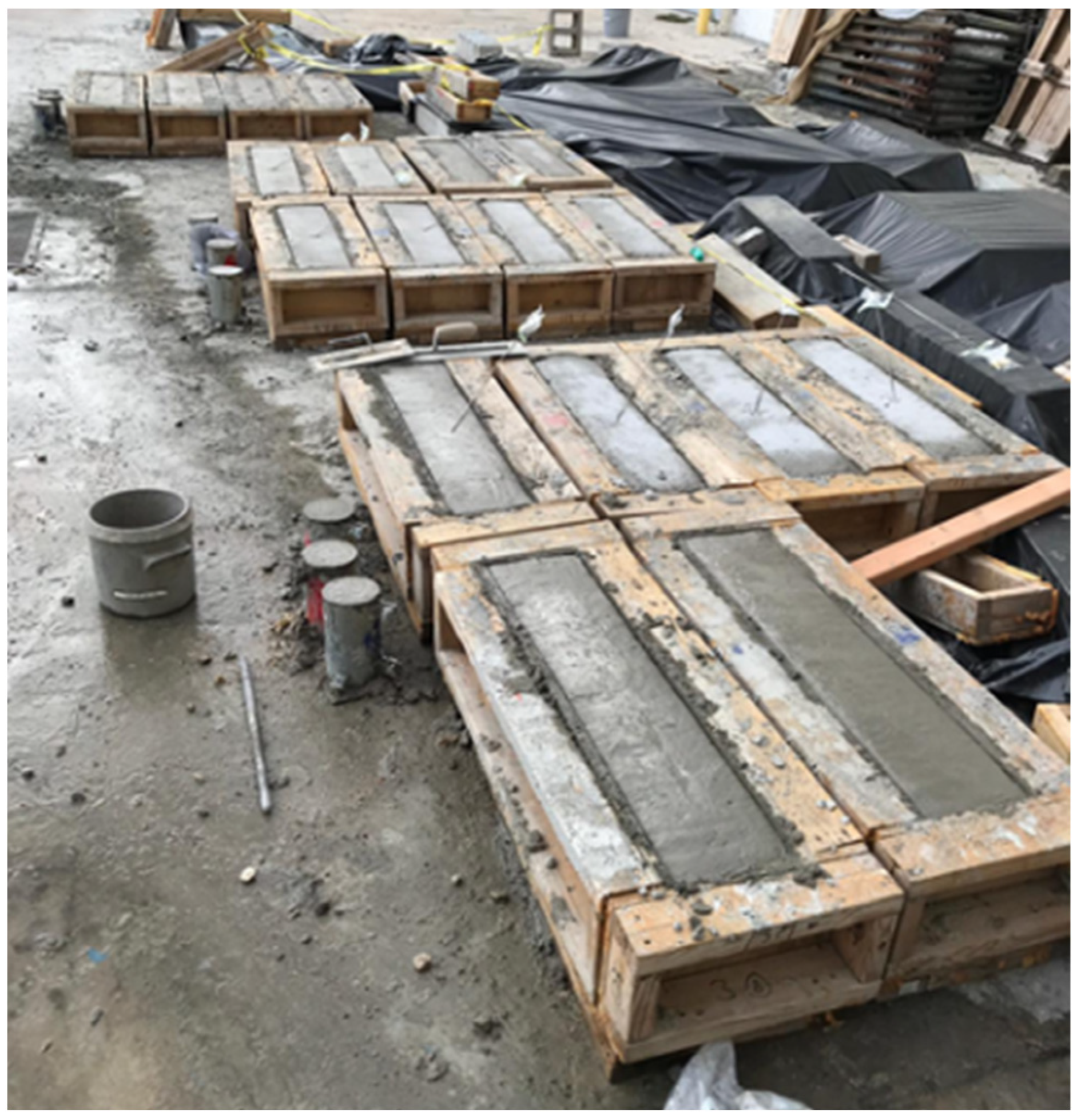
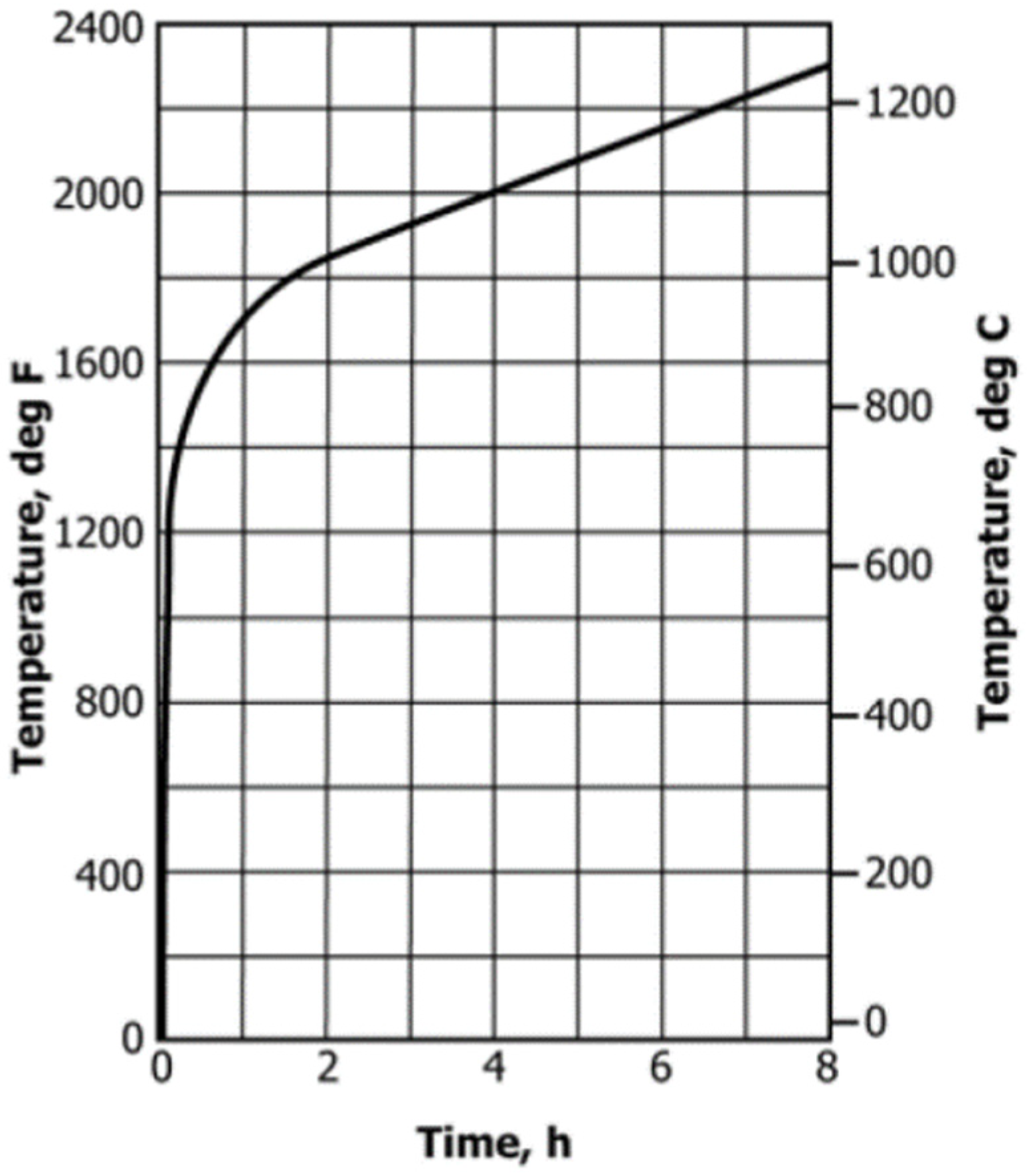
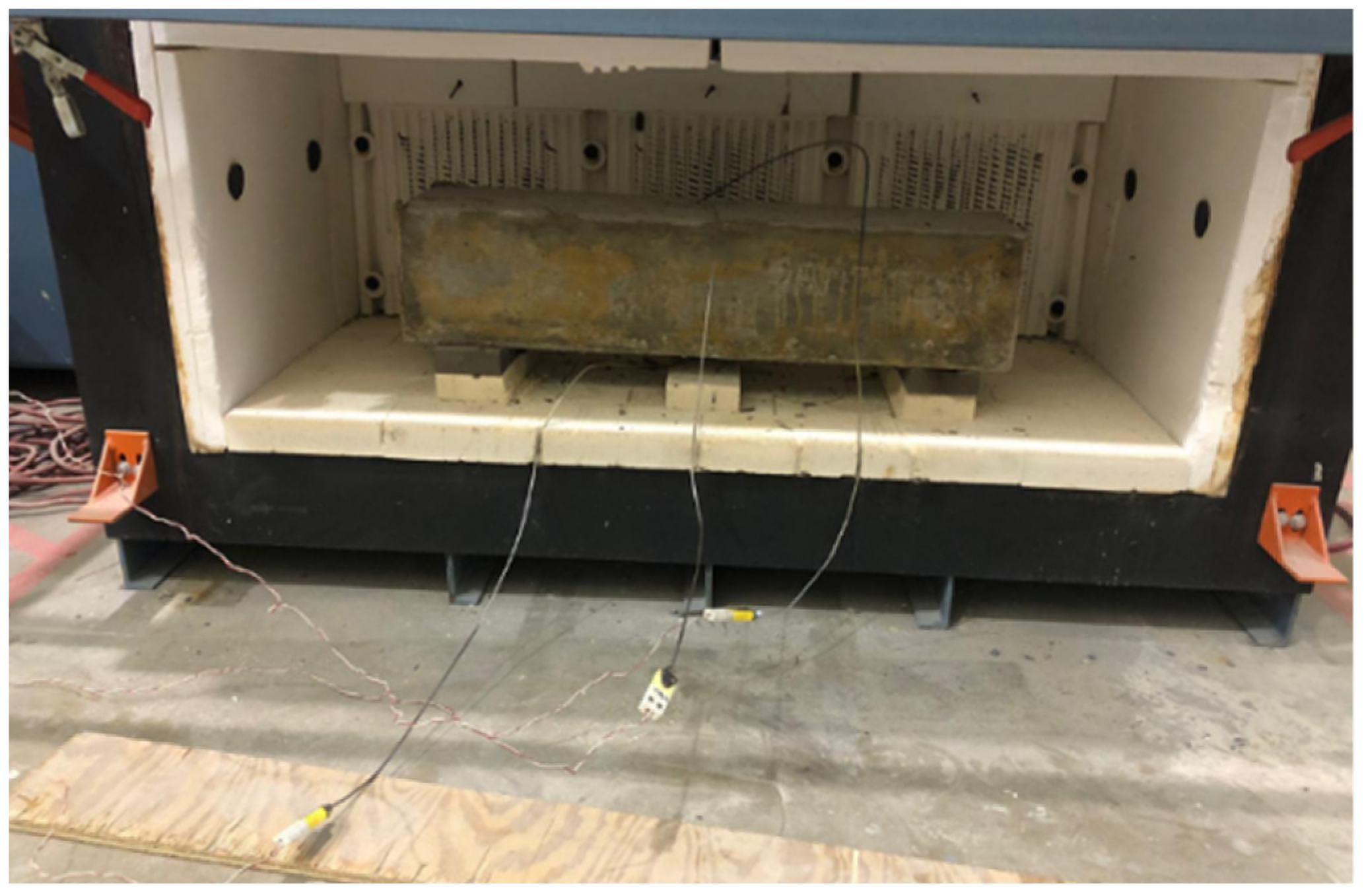
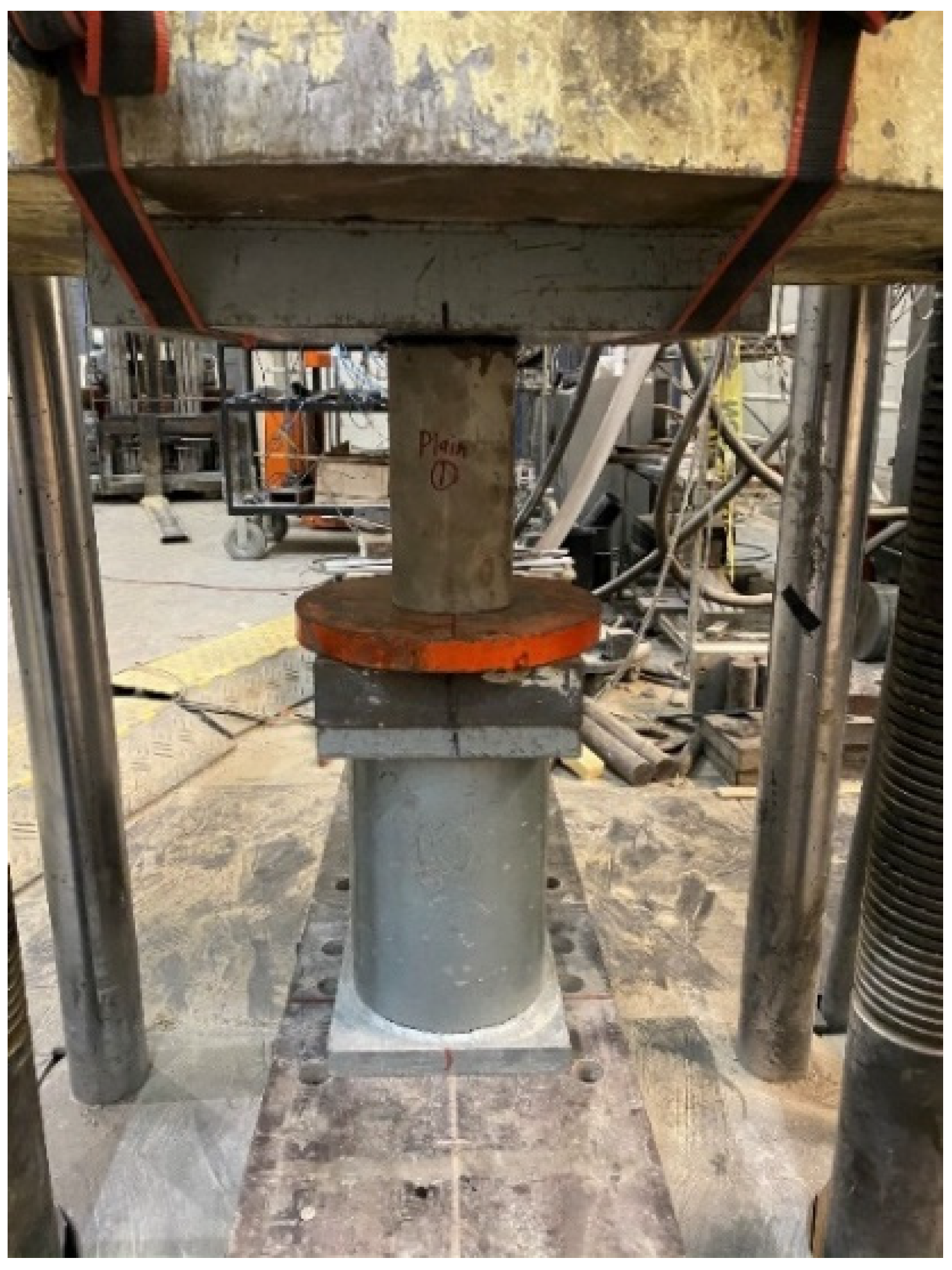

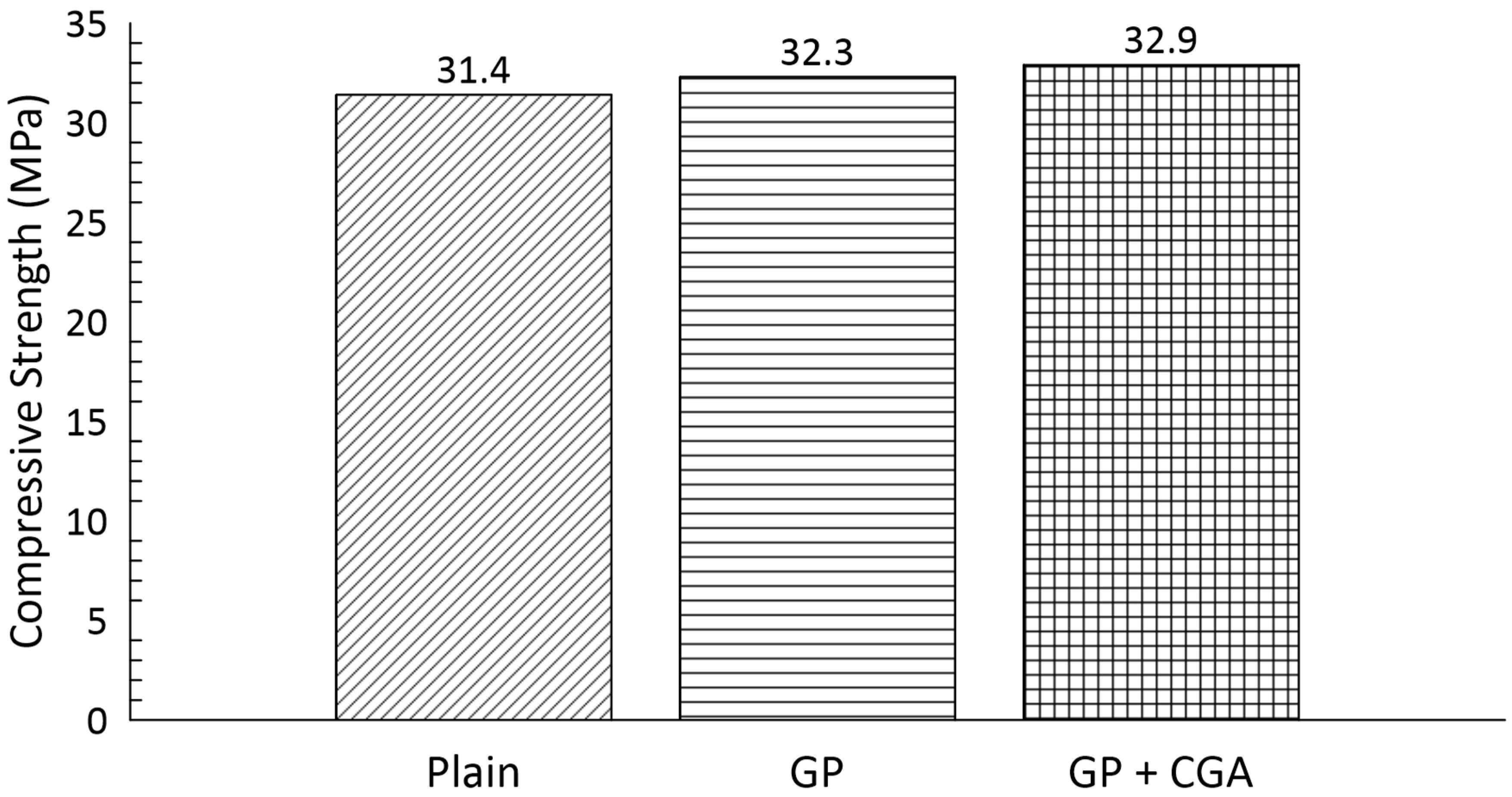
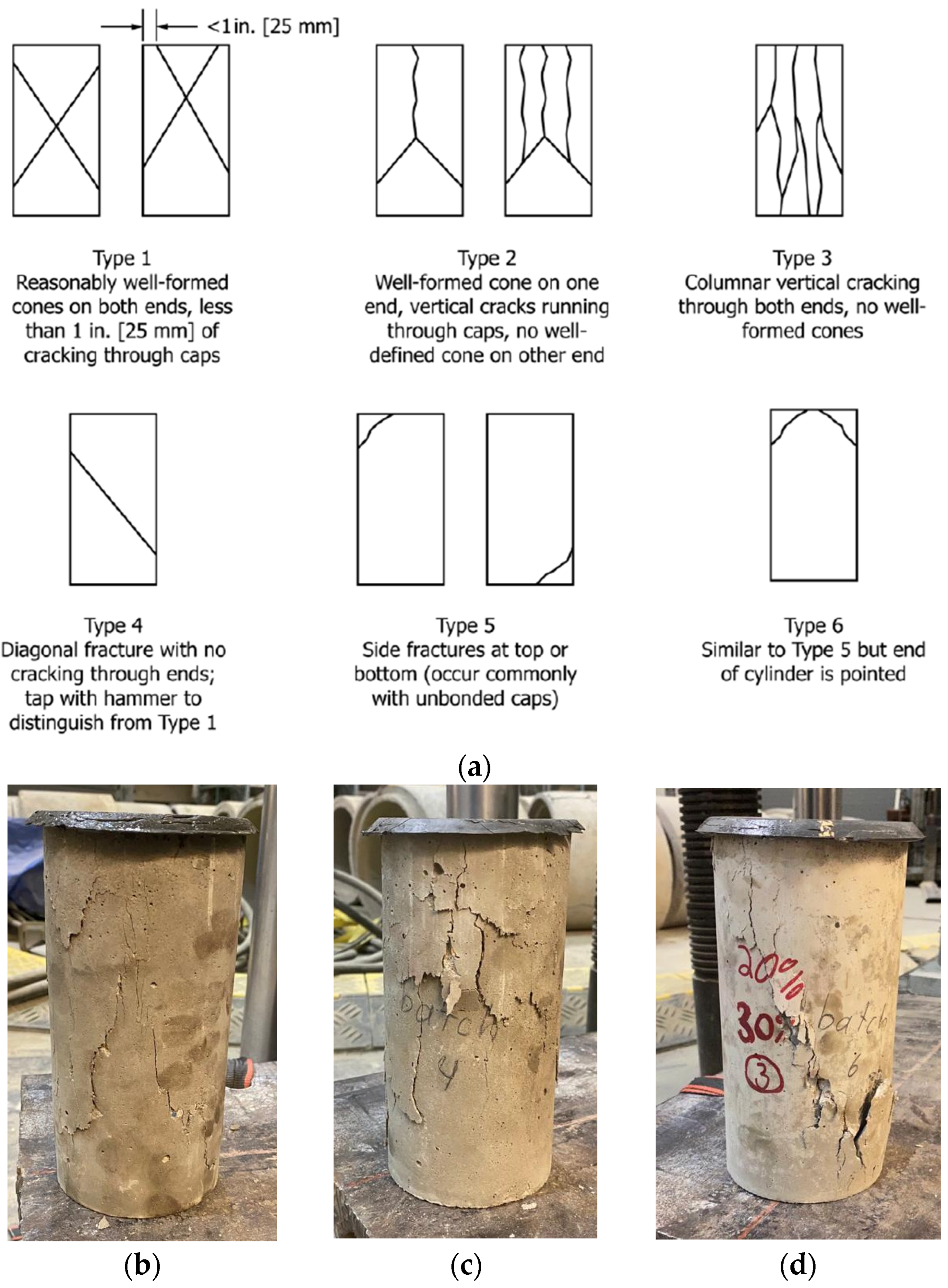
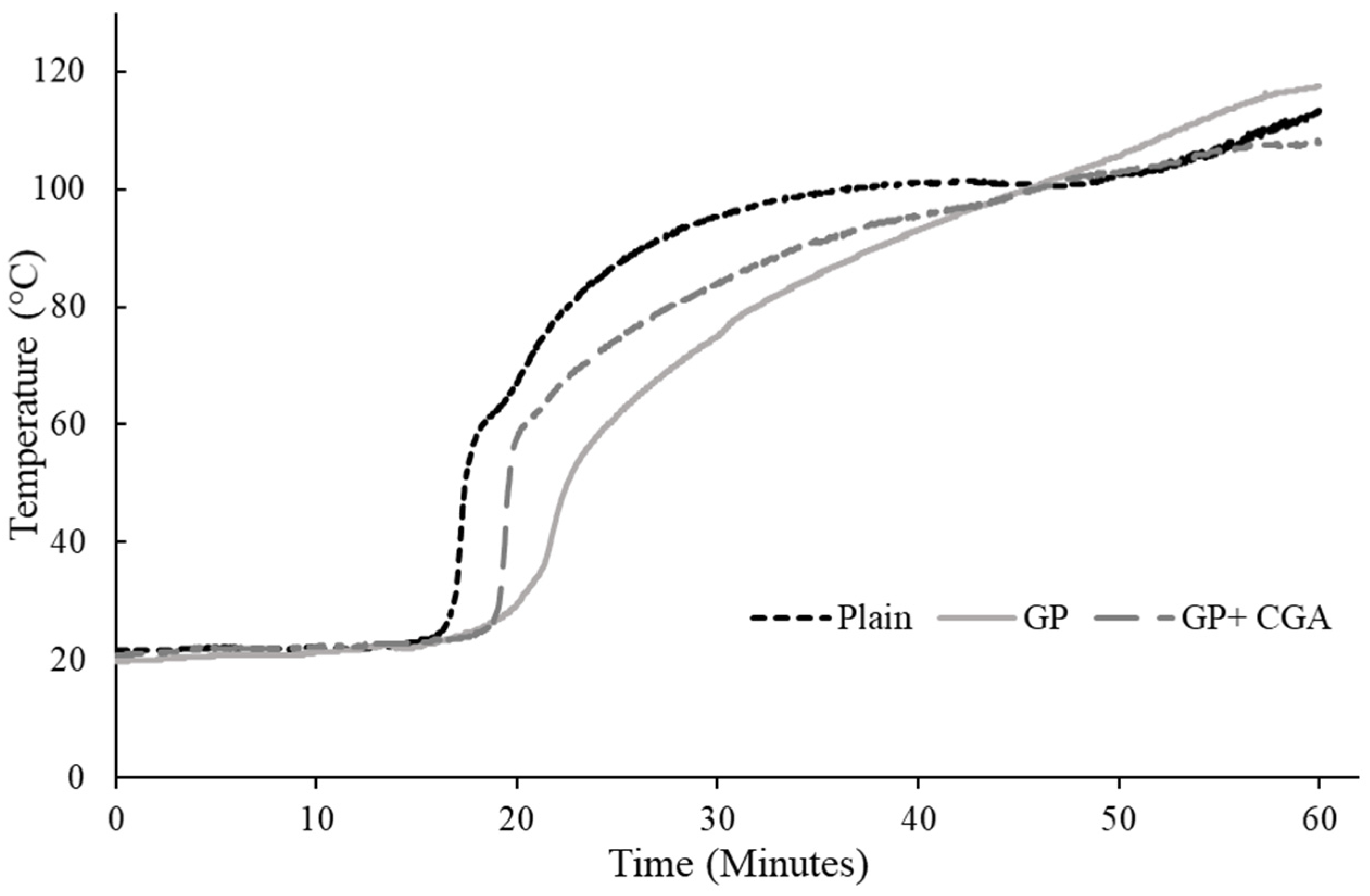

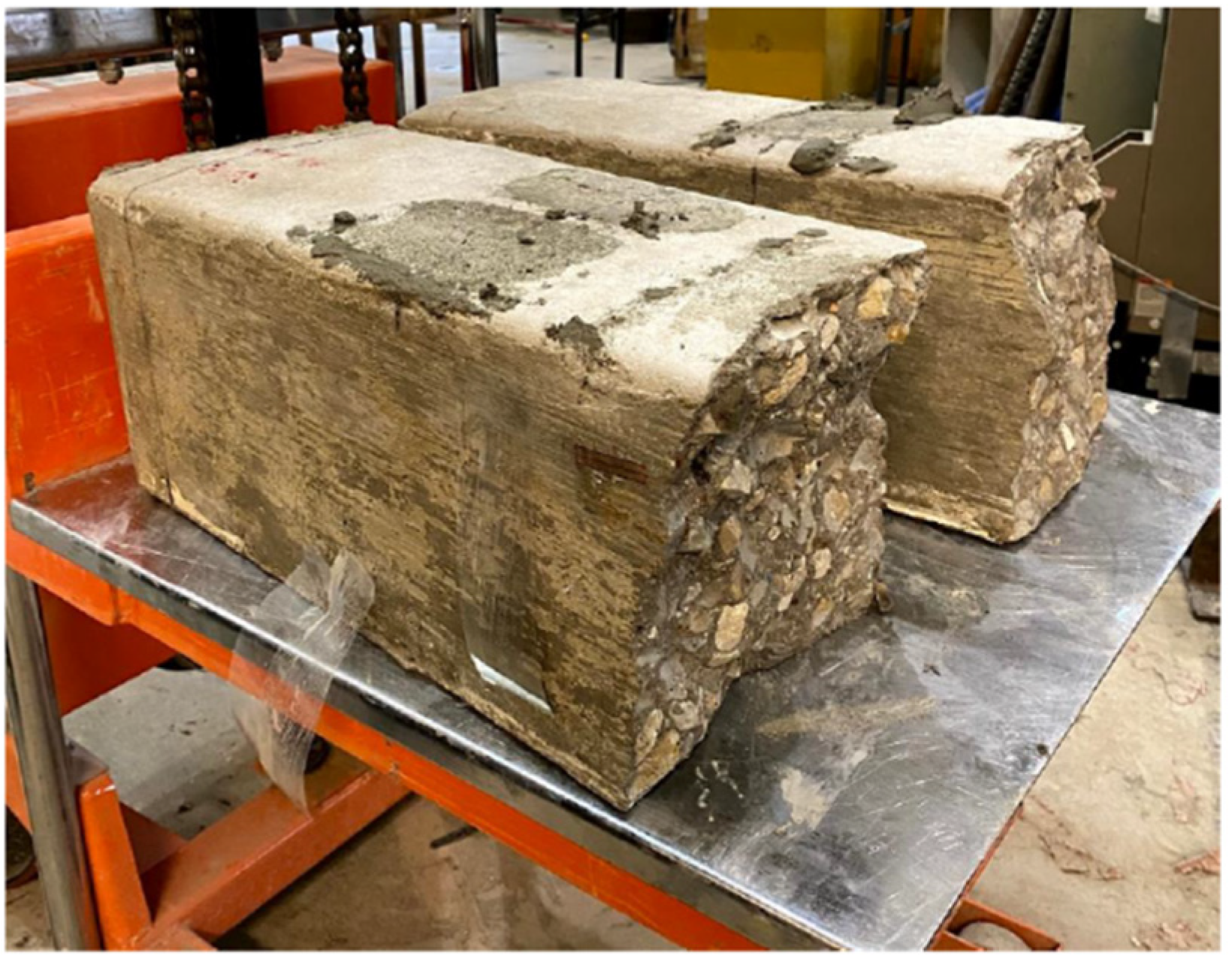
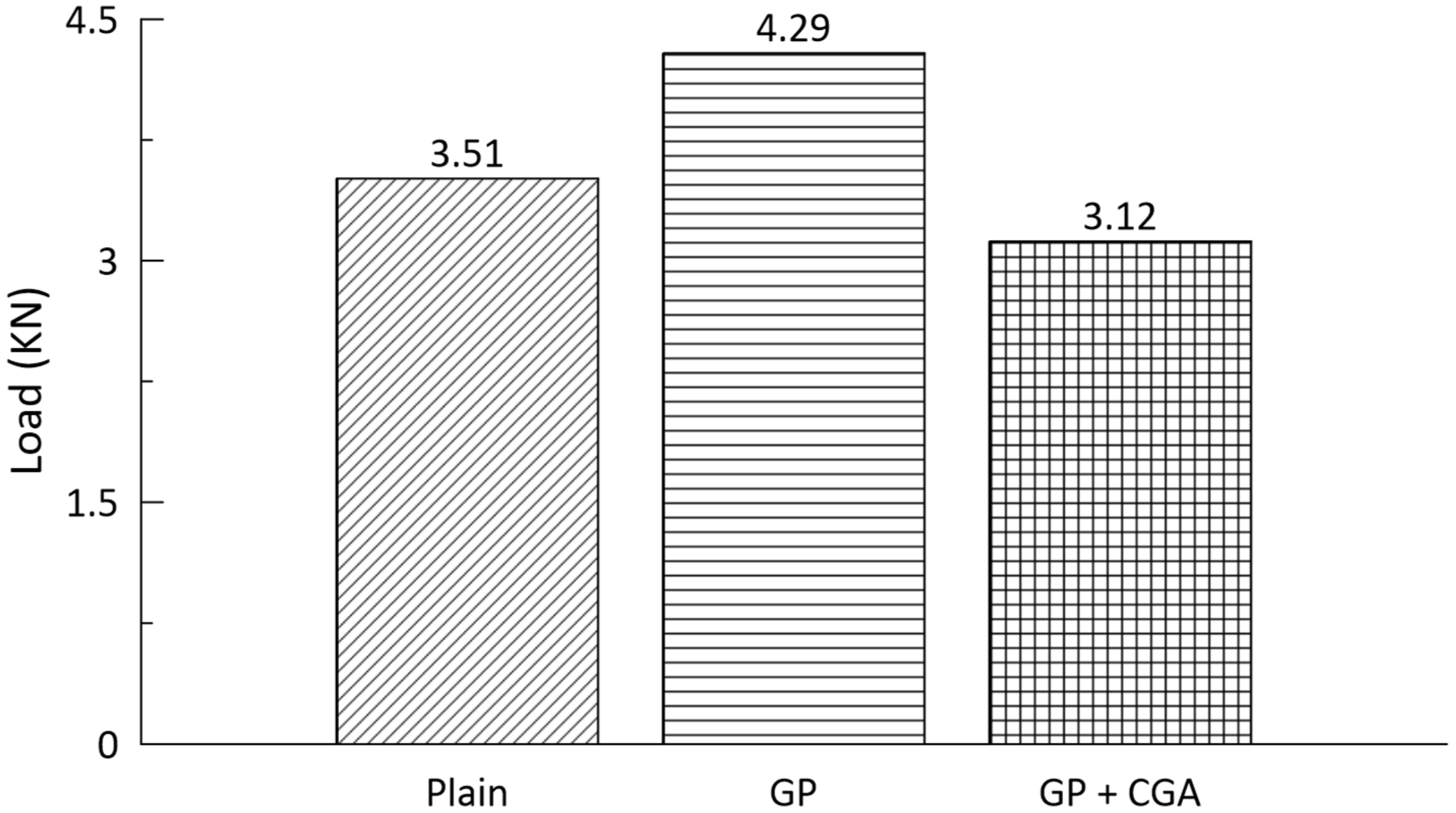
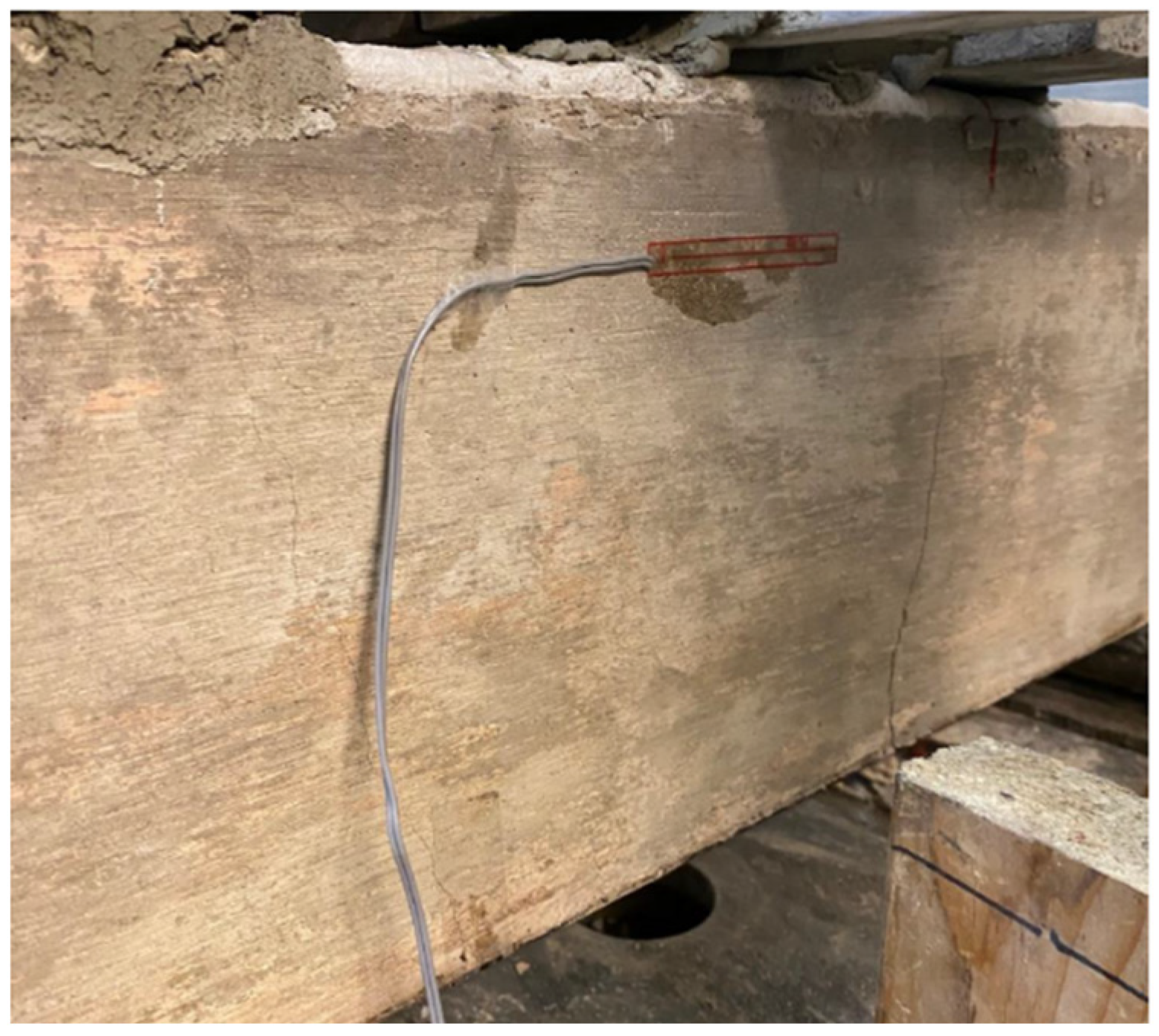
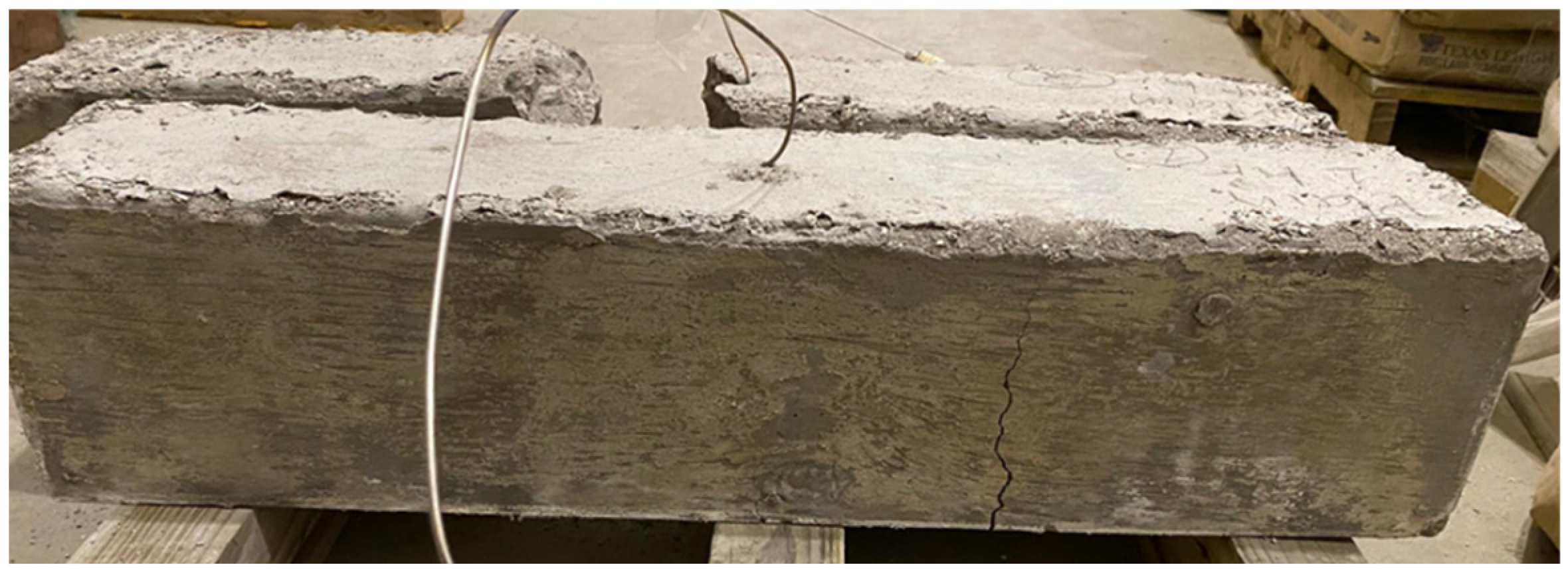
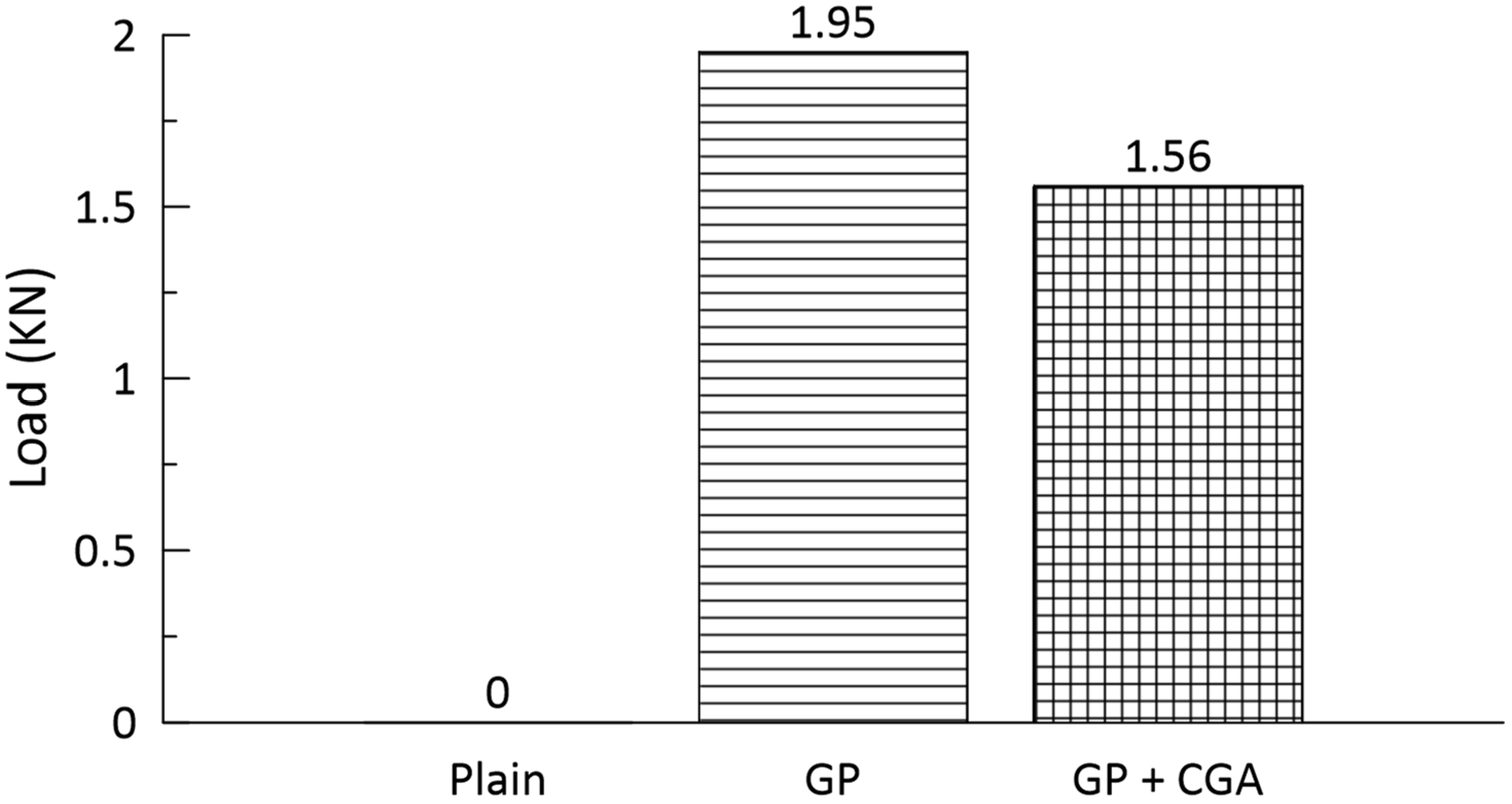
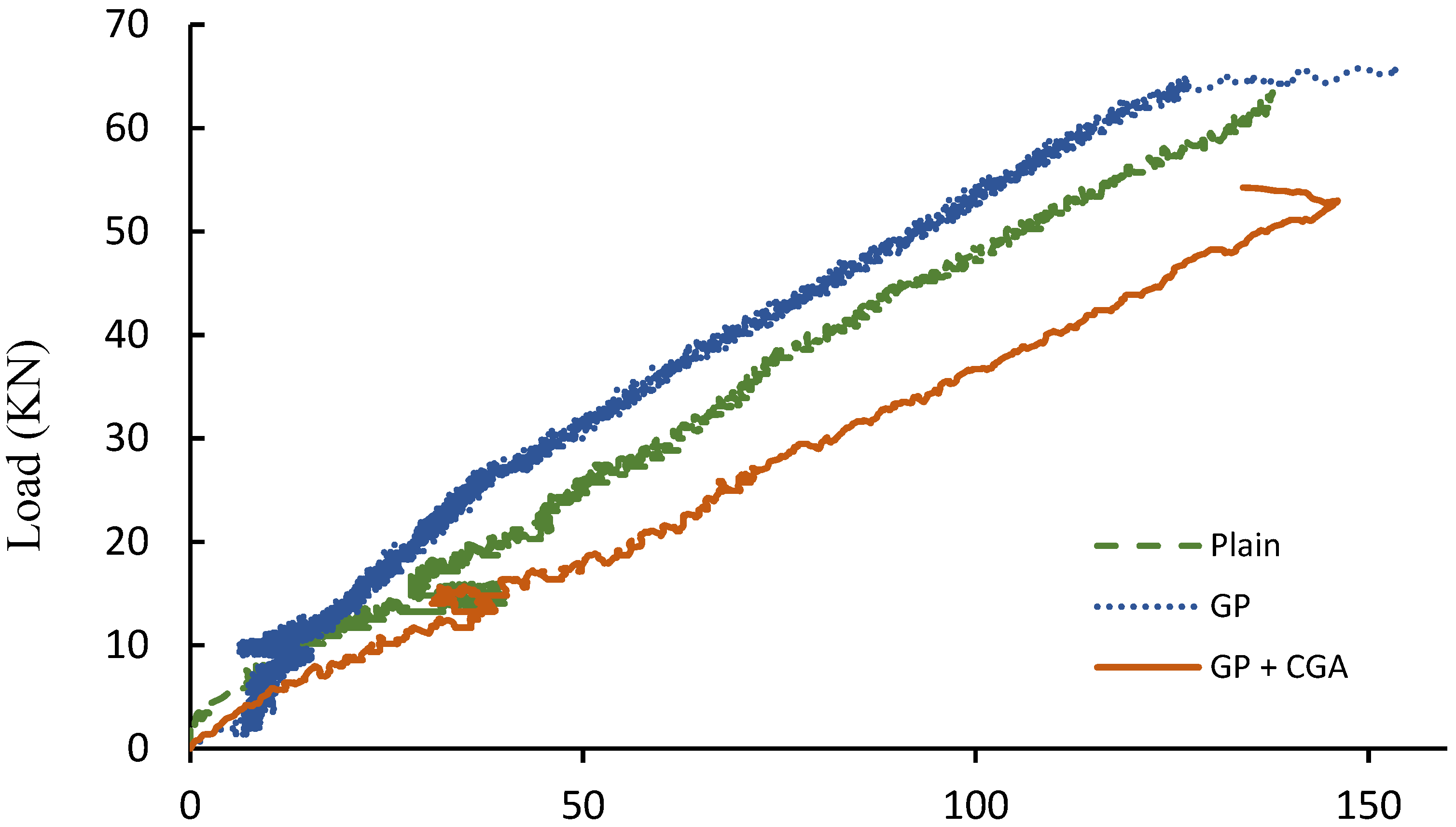
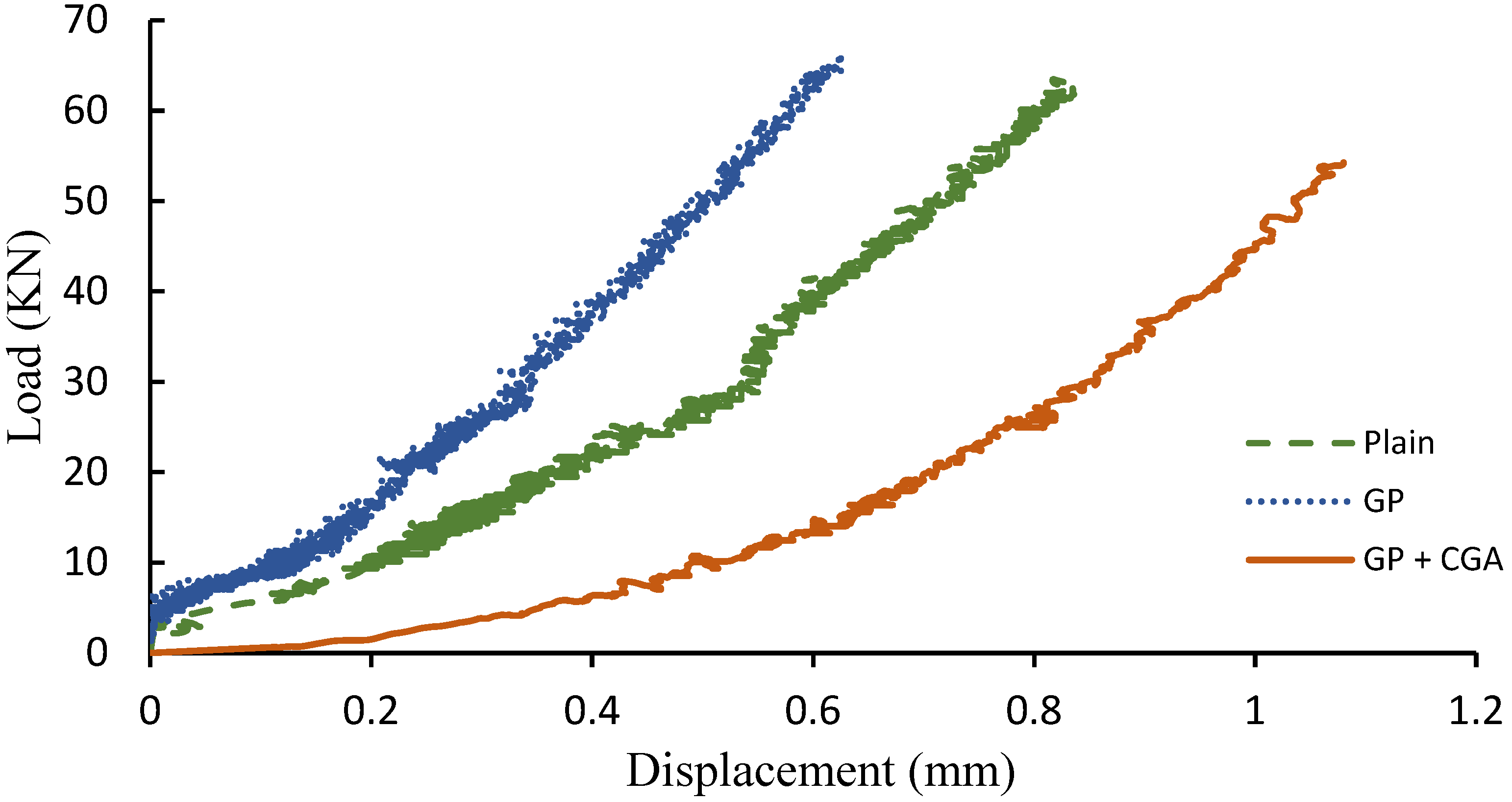
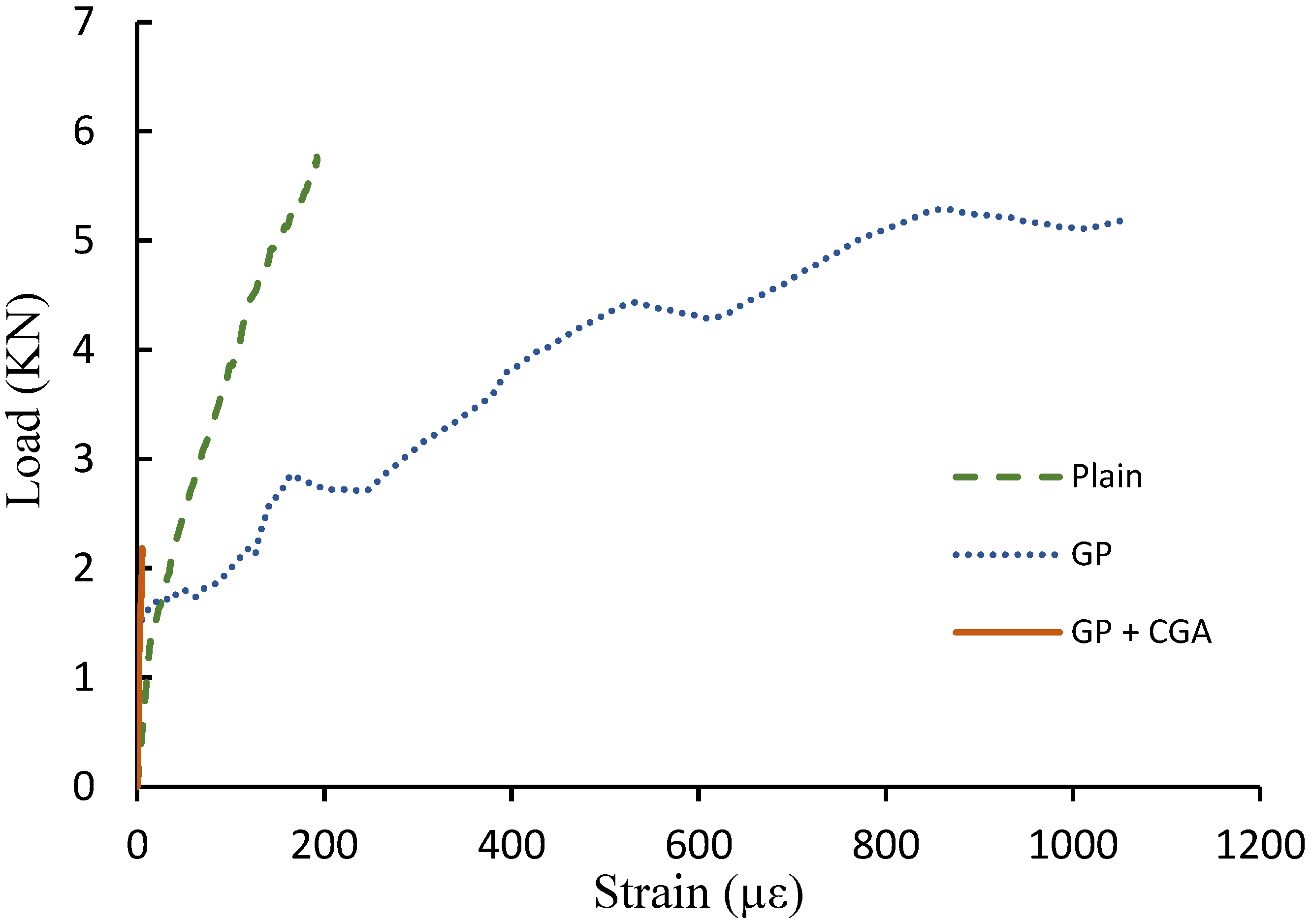
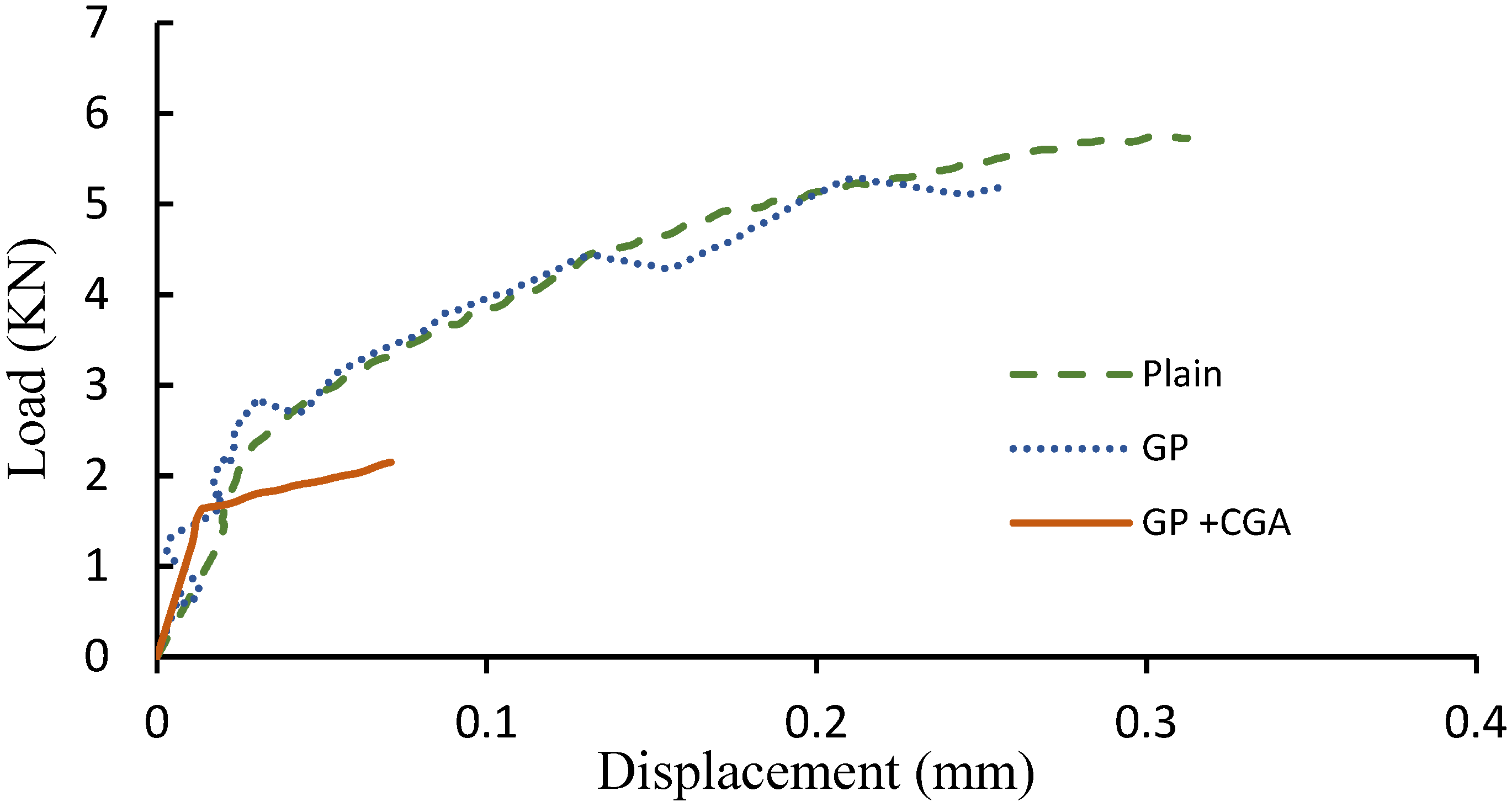
| No. | 20% GG Replacement | 30% CGA Replacement | Heat Treatment (Hours) | No. of Beams | Mix Type |
|---|---|---|---|---|---|
| 1 | Yes | No | No | 2 | GP |
| 2 | No | No | No | 2 | PC (control) |
| 3 | Yes | No | 0.5 | 2 | GP |
| 4 | No | No | 0.5 | 2 | PC |
| 5 | Yes | No | 1 | 2 | GP |
| 6 | No | No | 1 | 2 | PC |
| 7 | Yes | Yes | No | 2 | GP + CGA |
| 8 | Yes | Yes | 0.5 | 2 | GP + CGA |
| 9 | Yes | Yes | 1 | 2 | GP + CGA |
| Total | 18 |
| Ingredient | Weight (kg) | ||
|---|---|---|---|
| PC Beams | GP Beams | GP + CGA Beams | |
| Water | 185 | 185 | 185 |
| Cement | 344 | 291 | 291 |
| Regular coarse aggregate | 1033 | 1033 | 715 |
| Fine aggregate | 848 | 848 | 848 |
| Ground glass | None | 53 | 53 |
| Coarse glass aggregate | None | None | 291 |
| Mix | Slump (mm) | Air Content (%) | Temperature (°C) |
|---|---|---|---|
| PC | 165 | 1.8 | 28.3 |
| GP | 175 | 1.4 | 30.0 |
| GP + CGA | 146 | 2 | 32.8 |
Publisher’s Note: MDPI stays neutral with regard to jurisdictional claims in published maps and institutional affiliations. |
© 2022 by the authors. Licensee MDPI, Basel, Switzerland. This article is an open access article distributed under the terms and conditions of the Creative Commons Attribution (CC BY) license (https://creativecommons.org/licenses/by/4.0/).
Share and Cite
Tapia, E.G.; Yazdani, N. Flexural Capacity of Fire-Affected Concrete Members with Recycled Glass Aggregate and Glass Pozzolan. Fire 2022, 5, 207. https://doi.org/10.3390/fire5060207
Tapia EG, Yazdani N. Flexural Capacity of Fire-Affected Concrete Members with Recycled Glass Aggregate and Glass Pozzolan. Fire. 2022; 5(6):207. https://doi.org/10.3390/fire5060207
Chicago/Turabian StyleTapia, Enrique Gonzalez, and Nur Yazdani. 2022. "Flexural Capacity of Fire-Affected Concrete Members with Recycled Glass Aggregate and Glass Pozzolan" Fire 5, no. 6: 207. https://doi.org/10.3390/fire5060207
APA StyleTapia, E. G., & Yazdani, N. (2022). Flexural Capacity of Fire-Affected Concrete Members with Recycled Glass Aggregate and Glass Pozzolan. Fire, 5(6), 207. https://doi.org/10.3390/fire5060207





